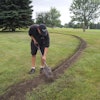
Various components working together make up a smart irrigation system, rather than simply a smart controller.
Rain Bird Corp.
Contrary to what some believe, a smart controller will not fix a faulty irrigation system.
“A smart controller will make poor design, installation and maintenance practices even more obvious,” s says Don Davis, irrigation training manager for SiteOne Landscape Supply. “Smart controller accessories can provide additional opportunities to avoid potential water waste.”
When those components work together with a smart controller, the system can help identify existing problems.
Davis and Steven Barendt, senior product manager for Rain Bird Corp., lay out a few additional accessories that can put the “smart” in “smart irrigation system.”
Controller
A smart controller uses weather data to monitor and adjust run times.
“It doesn’t know your zones simultaneously irrigate both sun and shade areas, and it doesn’t know you program every station with the same run time regardless of the sprinkler type or plant water requirements,” Davis says.
However, Barendt says the controller can help attain local weather information for a site via an on-site weather sensor and/or technology that enables the controller to gather weather information from the internet.
“Gathering weather information for the site allows controllers to make updates to run times to ensure we’re only giving the proper amount of water based on the local temperature,” Barendt says.
Most smart controllers require internet access. Irrigation pros should verify connectivity where the controller will be located prior to installation, Davis says.
Ideally, the system will also have a freeze/rain sensor.
“An on-site rain/freeze sensor will ensure that we’re not irrigating after a rain event or during a freeze event,” Barendt says.
Pressure regulator
Pressure-regulating technology helps ensure the pressure is consistent throughout the system and keeps the pressure within the manufacturer’s recommended range.
“If pressure is high, pressure regulation saves a tremendous amount of water,” Barendt says
Flow-sensing technology
Many systems are also compatible with flow sensing technology. Any variance in flow will create a local alarm at the controller and can provide text or email notifications via internet platforms.
Under a low flow condition, there may be a stuck valve or some other issue that is causing the landscape to not get the proper amount of water.
“Oftentimes, a flow sensor and installation pays for itself with one event, either a high flow condition where there is a broken mainline or lateral line with catastrophic loss of water, or a low flow condition where there may be loss of landscape at stake,” Barendt says.
Master valve
A normally closed master valve is an irrigation valve installed upstream of any other outlets in the irrigation system.
“The master valve is energized to open during an irrigation cycle, allowing pressurized water to reach the zone valves,” Davis says. “Upon completion of the irrigation cycle, the master valve is deenergized and closes.”
When the master valve is deenergized, this prevents water from flowing downstream.
Soil moisture sensor
Soil moisture sensors measure the volumetric water (actual water) content in the soil. If the sensor measures over a specific moisture threshold in the soil, it will suspend and irrigation cycle, preventing water applications when they are not needed, Davis says.
Both wired and wireless options are available, and an annual calibration may be needed for smarter watering results.
However, Barendt cautions that using a soil moisture sensor would require a user to find a single spot on a small/medium property or possibly a couple spots on a rather large commercial property that are representative of the entirety of the soil.
“This means that location of the sensor is critical and could be the downfall of the intended goal of an irrigation system: maintaining a healthy landscape,” Barendt says.
Barendt adds that hydrozoning is the key to an efficient and smart irrigation system. This means that plants with similar water needs are placed together, but also, irrigation zones or stations are assigned based on soil types and exposure to the elements (rainfall, sun, shade, etc.).
“If the system is set up this way and run times are scheduled accordingly, then smart controller weather adjustments would be more effective than a single sensor placed somewhere in the system,” Barendt says. “In this scenario, ‘more effective’ means striking the right balance of maintaining a healthy landscape while conserving the maximum amount of water.”




















